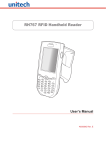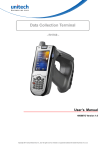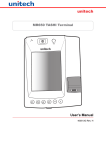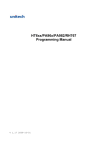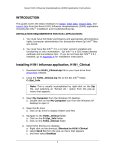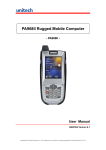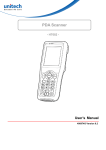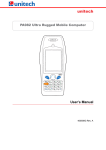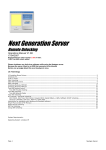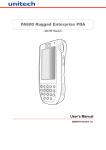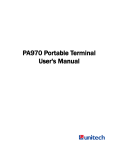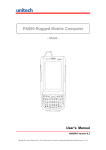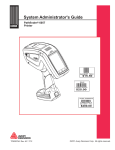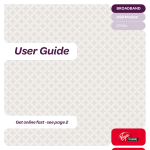Download Unitech RH767 User`s manual
Transcript
RH767 RFID Handheld Reader User’s Manual 400558G Rev. G Preface About This Manual This manual explains how to install, operate and maintain the RH767. No part of this publication may be reproduced or used in any form, or by any electrical or mechanical means, without permission in writing from the manufacturer. This includes but is not limited to photocopying, recording, or information storage and retrieval systems. The material in this manual is subject to change without notice. © Copyright 2009 Unitech Electronics Co., Ltd. All rights reserved. Unitech global Web site address: http:\\www.unitech-adc.com Bluetooth is a registered trademark of Bluetooth SIG. Microsoft, Windows and ActiveSync are either registered trademarks or trademarks of Microsoft Corporation. Other product names mentioned in this manual may be trademarks or registered trademarks of their respective companies and are hereby acknowledged. Unitech is a member of the Oracle Embedded Software Licensing Program. Regulatory Compliance Statements Federal Communication Commission Interference Statement This equipment has been tested and found to comply with the limits for a Class B digital device, pursuant to Part 15 of the FCC Rules. These limits are designed to provide reasonable protection against harmful interference in a residential installation. This equipment generates, operates and can radiate radio frequency energy, and if not installed and used in accordance with the instructions, may cause harmful interference to radio communications. However, there is no guarantee that interference will not occur in a particular installation. If this equipment does cause harmful interference to radio or television reception, which can be determined by turning the equipment off and on, the user is encouraged to try and correct the interference through one of the following: ●● Relocate the receiving antenna. ●● Increase the separation between the equipment and receiver. ●● Connect the equipment into an outlet on a circuit that is different from the receiver. ●● Consult the dealer or an experienced radio/television technician for help. FCC Caution: Any changes or modifications not expressly approved by the party responsible for compliance could void the user’s authority to operate this equipment. This device complies with Part 15 of the FCC Rules. Operation is subject to the following two conditions: (1) This device may not cause harmful interference, and (2) this device must accept any received interference, including interference that may cause undesired operation. This device and its antenna(s) must not cohabitate or operate in conjunction with any other antenna or transmitter. i FCC Radiation Exposure Statement This equipment complies with FCC radiation exposure limits set forth for an uncontrolled environment. End users must follow the specific operating instructions for satisfying RF exposure compliance. Please follow the operation instructions in this manual to maintain compliance with FCC RF exposure requirments. This RFID Handheld Terminal meets FCC RF exposure guidelines when used in handheld or desktop operation. RoHS Statement This device conforms to RoHS (Reduction of Hazardous Substances) European Union regulations that set maximum concentration limits on hazardous materials used in electrical and electronic equipment. Laser Information The Unitech RH767 series is certified in the U.S. to conform to the DHHS/CDRH 21CFR Subchapter J and IEC 825-1 requirnments. In addition, Class II and Class 2 products are not considered to be hazardous. The RH767 series contains an internal Visible Laser Diode (VLD) whose emissions do not exceed the maximum limits as set forth in the above regulations. The scanner is designed so that there is no human access to harmful laser light during normal operation, user maintenance or during prescribed service operations. The laser safety warning label required by the DHHS/IEC is located on the RH767's back panel. CAUTION! Use of controls or adjustments or performance of procedures other than those specified herein may result in hazardous laser light. Use of optical instruments with the scanner will increase eye hazard. Optical instruments include binoculars, microscopes and magnifying glasses. This does not include eye glasses worn by the user. IMPORTANT NOTE FCC Radiation Exposure Statement: This equipment complies with FCC radiation exposure limits set forth for an uncontrolled environment. This equipment should be installed and operated with a minimum distance of 1.5 cm between the radiator and the user's body. Warranty Unitech Limited Warranty covers the following items that are free from defects during normal use: ●● RH767 – 1-year limited warranty. ●● Lithium-Ion battery – 6-month limited warranty. the warranty becomes void if equipment is modified, improperly installed/used, damaged by accident/neglect, or if any parts are improperly installed or replaced by the user. Use only the AC Adapter supplied. Using the wrong AC Adapter may damage the RH767 and will void the warranty. ii Battery Notices This Unitech RH767 is equipped with a Lithium-Ion Battery Pack and a Backup Battery. However, the RH767 may not start without an external power source due to battery discharge after extended storage periods. To charge the battery to full capacity, connect the RH767 to an external power source with the USB Charging Cable or the Unitech RH767 Cradle. Initially charge the RH767 for at least 16 hours. The Backup Battery will receive power from an external power source, or through the main battery (But, only if the main battery has adequate power). In order to prevent data loss due to Backup Battery failure, connect the RH767 to the main Battery Pack or an external power source. NOTE: Turn the RH767 Backup Battery Switch to the ON position before initial use. To garauntee optimal performance, replace rechargeable batteries every year or after 500 charge/discharge cycles. It is normal for the battery to physically expand after one year or 500 cycles. Although it does not cause harm, the battery can not be used again and must be disposed of according to local battery saftey disposal procedures. If the performance decrease is greater than 20 percent in a Lithium-Ion battery, the battery is at the end of its life cycle. Do not continue to use the battery, and ensure that the battery is properly disposed. The length of time that a battery power lasts depends on the battery type and how the device is used. Conserve battery life through the following: ●● Avoid frequent full discharges because this places additional strain on the battery. Several partial discharges with frequent recharges are better than a deep one. Recharging a partially charged Lithium-Ion battery does not cause harm because there is no memory. ●● Keep the Lithium-Ion battery cool. Avoid a hot car. For prolonged storage, keep the battery at a 40 percent charge level. ●● Do not leave the lithium-Ion battery discharged and unused for an extended time period because the battery will wear out and the longevity of the battery will be at least shorter than half of the one with frequent recharges. Battery Charge Notice It is important to consider the environment temperature when charging the Lithium-Ion Battery Pack. Charging is most efficient at room temperature or in a slightly cooler environment. It is essential that batteries are charged within the temperature ranges of 32º F - 104ºF (0°C - 40°C). Charging batteries outside of the specified temperature range could damage the batteries and shorten their charging life cycle. CAUTION! Do not charge batteries at a temperature lower than 32ºF (0°C), which will increase the internal resistance to cause heat and make the batteries unstable and unsafe. Please use a battery temperature detecting device for a charger to ensure a safe charging temperature range. Storage and Safety Notice Although charged Lithium-Ion batteries may be left unused for several months, their capacity may deplete due to buildup of internal resistance. In this case they will require recharging. Lithium-Ion batteries may store at temperatures between -4Fº - 140Fº (-20°C to 60°C). But the batteries may deplete more rapidly at the warmer end of this range. It is recommended to store batteries at room temperature. iii Table of Contents Preface....................................................................................i Regulatory Compliance Statements................................................................................ i Federal Communication Commission Interference Statement.................................. i About This Manual................................................................................. i FCC Radiation Exposure Statement......................................................................... ii RoHS Statement....................................................................................................... ii Laser Information........................................................................................................... ii Warranty......................................................................................................................... ii Battery Notices...............................................................................................................iii Battery Charge Notice..............................................................................................iii Storage and Safety Notice........................................................................................iii Chapter 1...............................................................................1 Introducing the RH767...................................................................................................1 Features....................................................................................................................1 Getting Started...................................................................................... 1 Package Contents..........................................................................................................2 A Tour of the RH767.......................................................................................................3 Back View.................................................................................................................4 Bottom View..............................................................................................................5 Setting up the RH767.....................................................................................................5 Installing the Battery Pack........................................................................................5 Charging the Battery.................................................................................................8 Charging the Battery using the Synchronization Power Cable........................... 8 Charging the Battery with the Docking Station.................................................... 8 Checking the Battery Status................................................................................ 9 Connecting the RH767 to a PC................................................................................9 Turning the RH767 on for the First Time................................................................. 10 Powering On.....................................................................................................10 Using the Stylus................................................................................................ 11 Calibrating the RH767 Screen.......................................................................... 11 Setting the Time and Date................................................................................ 13 Adjusting the Screen Brightness....................................................................... 13 Chapter 2.............................................................................14 Using Function keys...............................................................................................14 Using the Hardware............................................................................ 14 Toggle to Alpha Mode and CAPS........................................................................... 15 Using the Windows CE Keyboard........................................................................... 16 Entering Characters..........................................................................................16 Moving the Keyboard........................................................................................16 Adjusting Settings.........................................................................................................17 Checking the Main and Backup Battery Status............................................................ 18 Using the Laser Scanner..............................................................................................19 Scanner Settings..........................................................................................................20 Scan2Key.....................................................................................................................21 Using the RFID.............................................................................................................21 Launching the RFID Demo Program...................................................................... 21 Chapter 3.............................................................................23 Establishing Device-PC Connection.............................................................................23 Installing Microsoft ActiveSync...............................................................................23 Connecting the Device to the Computer................................................................. 23 Getting Connected.............................................................................. 23 Using ActiveSync to Exchange Files............................................................................24 Using the WLAN...........................................................................................................25 Setting up the Wireless Local Area Network Card.................................................. 25 Obtaining an IP Address via DHCP Server....................................................... 25 Specifying an IP Address..................................................................................26 Wi-Fi Connection...............................................................................................27 Using the Summit Utilities................................................................................. 29 Admin Login............................................................................................................29 Scan Available AP...................................................................................................29 Encryption...............................................................................................................30 Commit and Activate...............................................................................................30 Appendix A...........................................................................31 Middleware Supporting List................................................................. 31 Appendix B...........................................................................32 System Specifications......................................................................... 32 Appendix C...........................................................................33 Worldwide Support.............................................................................. 33 v Chapter 1 Getting Started Introducing the RH767 RH767 UHF Unitech’s RH767 Ultra High Frequency (UHF) handheld terminal is a rugged dual technology multi-tag UHF RFID and bar code reader. It can read both EPC Gen 1 and Gen 2 RFID tags and the device is embedded with RFID middleware and Windows CE 5.0. The RH767 has a battery life of up to 12 hours. Connectivity options include WLAN 802.11b/g and Bluetooth. It has an IP54 electronic enclosure sealing rating against the elements and a 4' (1.2 meter) drop threshold to concrete. RH767 HF Unitech’s RH767 High Frequency (HF) handheld terminal is a rugged dual technology multitag HF RFID and bar code reader. It can read 15693/ISO 1443A/B RFID tags and the device is embedded with RFID middleware and Windows CE 5.0. The RH767 has a battery life of up to 20 hours. Connectivity options include WLAN 802.11b/g, and Bluetooth and GPRS is possible via the PCMCIA slot. It has an IP54 electronic enclosure sealing rating against the elements and a 4' (1.2 meter) drop threshold to concrete. Features ●● ●● ●● ●● ●● ●● ●● Dual Technology Bar Code Scanner & RFID (HF or UHF) Reader. Embedded RFID Middleware. Built-in Bar Code Scanner. IP54 Rated and 4' (1.2m) Drop Threshold. Windows CE 5.0 Professional Plus Operating System. WLAN 802.11b/g and Bluetooth Connectivity. GPRS via PCMCIA slot (HF Model Only). 1 Package Contents Make sure the following items are in the RH767 box: RH767 Terminal Power Adapter and Cable Battery Pack Stylus Synchronization and Power Cable CD-ROM Quick Reference Guide Cradle (Optional) Please contact a regional Unitech service representative if anything is missing or appears damaged. 2 Copyright 2009 Unitech Electronics Co., Ltd. All rights reserved. Unitech is a registered trademark of Unitech Electronics Co., Ltd. Chapter 1 Getting Started A Tour of the RH767 Front View No. Component 1. 2. 3. 4. 5. 6. 7. Status Indicator. Description Indicates battery and bar code scanning status. Green - Battery charge is complete or a bar code is successfully captured. Red - Battery is charging, bar code scanner is activated and processing. LCD Touch-screen. Displays the applications and data stored on the device. The screen is touch-sensitive and responds to the stylus or finger. Alpha Mode Indicator. Indicates Alpha Mode status. Keypad. Keypad interface for controlling the RH767. See Using the Hardware on page 14 for more information. Power Button. Press this button to start the RH767. Alternatively, this key must be pressed down for at least two seconds to turn off the RH767. Microphone. Receives sound. Right Scanner Trigger Button. Press to activate the Laser Bar Code Scanner. 3 Back View No. Component 8. Stylus. 9. 10. Bar Code Scanner Window. Infrared (IR) Port. 11. 12. 13. 14. Left Scanner Trigger Button. Reset Button. Bar Code Scanner Trigger. Battery Compartment. 15. 16. Strap Hook. RFID Antenna. Description Remove the Stylus from its holder and hold it like a pen. Scans bar codes. Utilizes infrared technology to transmit and receive data from other IR-enabled devices. Press to activate the laser bar code scanner. Use a paper clip to press the Reset Button. Press to activate the Bar Code Scanner. Houses the removable and rechargeable 7.4V LithiumIon 4050mAh Battery Pack. Secures the strap to the RH767. Receives data from an RFID tag. 4 Copyright 2009 Unitech Electronics Co., Ltd. All rights reserved. Unitech is a registered trademark of Unitech Electronics Co., Ltd. Chapter 1 Getting Started Bottom View No. Component 17. 18. Battery Compartment. Universal Connector. 19. PCMCIA Compartment Description Houses the rechargeable Lithium-Ion Battery Pack. Connects the RH767 to the Synchronization Power Cable, which connects to the computer’s USB Port. It also connects to the AC Adapter, which plugs into an external power source. This charges the device and performs Microsoft ActiveSync operation. Open this compartment to access the PCMCIA slot. (It is optional to purchase the RH767 preloaded with a PCMCIA Card, but only with the HF model.) Setting up the RH767 Install and charge the battery, check the battery status, connect the RH767 to a PC, turn on the RH767 for the first time, install an optional Wireless Local Area Network PCMCIA card and calibrate the screen through the following: Installing the Battery Pack WARNING! If the battery pack is handled improperly there is risk of fire or burns. Do not disassemble, crush, puncture, short external contacts, or dispose the battery pack in fire or water. Do not attempt to open or service the battery pack. Dispose of used batteries according to local recycling guidelines. The backup battery prevents data loss when the main battery disconnects from the RH767. This backup battery cell will only support the RH767 for a maximum of 72 hours. NOTE: ●● T urn the RH767's Backup Battery Switch to the ON postition and charge the main battery pack for at least 16 hours before initial use. See page 6 for more informaiton. 5 1. Open the Battery Compartment by sliding the tabs in the direction as shown below: 2. Locate the Backup Battery Switch and turn it to the ON position. Backup Battery Switch 3. Align the Battery Contacts with the Battery Compartment Contacts as shown below: Battery Contacts 6 Copyright 2009 Unitech Electronics Co., Ltd. All rights reserved. Unitech is a registered trademark of Unitech Electronics Co., Ltd. Chapter 1 Getting Started 4. P lace the Battery Pack into the Battery Compartment and press the battery securely into place. 5. R eplace the Battery Compartment cover, push down the tabs and slide them back into the lock position as shown below: 7 Charging the Battery Charge the RH767 for at least 16 hours before initial use. Charge the device to full capacity after a full day of use with the Synchronization Power Cable or the Docking Station. CAUTION! Operating the RH767 for the first time without fully charging the Backup Battery may result in data loss stored in the RAM memory. When the Main Battery is removed, the Backup Battery retains data in the RAM memory for 72 hours; charge the battery as soon as possible to avoid data loss. NOTE: T urn the Backup Battery Switch to the ON position before charging the battery. Data loss may occur if the Backup Battery is not properly charged. Charging the Battery using the Synchronization Power Cable 1. Connect the Synchronization Power Cable Connector to the RH767 (1). 2. Plug the AC Adapter cable into the USB Connector's power jack (2). 3. Connect the AC Adapter into an electrical outlet (3). Charging the Battery with the Docking Station 1. P lug the AC Adapter cable into the Docking Station's power jack, then connect the AC Adapter into an electrical outlet. 8 Copyright 2009 Unitech Electronics Co., Ltd. All rights reserved. Unitech is a registered trademark of Unitech Electronics Co., Ltd. Chapter 1 Getting Started 2. S lide the RH767 into the Docking Station until it clicks into place. 3. The connection is secure when the bottom edge of the device aligns with the docking station. (The Docking Station's LED indicator lights up green, while the RH767's LED indicator lights up red.) LED Status RH767 Docking Station LED Description Solid Red Solid Green Solid Green Charging. Charging Complete. Power is On. Checking the Battery Status If the main battery level becomes low in the appears course of normal use, a status icon on the RH767 screen's system tray indicating low or very low battery status. In both cases, perform a Microsoft ActiveSync operation to backup data, then recharge the device as soon as possible. If the battery level reaches low status, the device will enter suspend mode; if the battery level reaches very low status, the device will enter deep sleep mode. In this case, recharge the Battery within 72 hours. When the backup battery charge is low, an icon indicating that appears in the system tray the backup battery should be charged as soon as possible. Connecting the RH767 to a PC Use the Synchronization Power Cable to connect the RH767 to a PC. 1. Connect the USB Connector jack to the RH767 (1). 2. P lug the USB Connector into the PC's serial port and connect the AC Adapter into the USB Connector (2). 3. Connect the AC Adapter into an electrical outlet (3). 9 Turning the RH767 on for the First Time The device is ready for use after it has been charged for at least 16 hours. Start-up the device to adjust the screen brightness, calibrate the display, and set up the system time zone date and time. Powering On 1. Turn on the device by pressing the Power Button on the RH767's front panel. 2. The Unitech RH767 welcome screen appears followed by the calibration screen. Power Button 10 Copyright 2009 Unitech Electronics Co., Ltd. All rights reserved. Unitech is a registered trademark of Unitech Electronics Co., Ltd. Chapter 1 Getting Started Using the Stylus CAUTION! Never use anything other than the RH767 Stylus on the screen. 1. Remove the Stylus from its holder. 2. Hold the stylus like a pencil. 3. L ightly tap the tip of the Stylus to make a menu choice. 4. D ouble-tap to open programs. 5. Use the Stylus to print letters or numbers. Calibrating the RH767 Screen The calibration screen automatically appears when the unit powers on for the first time or after the system is reset. 11 Access the callibration screen at any time by simultaneously pressing the Func and ESC key. Func Key ESC Key Use a stylus to tap a sequence of target marks on the RH767’s screen. Firmly hold the stylus on top of the target mark for a moment, and then remove. Continue to tap the target mark as it stops along the corners of the screen. Press Enter to confirm the calibration or press ESC to cancel. 12 Copyright 2009 Unitech Electronics Co., Ltd. All rights reserved. Unitech is a registered trademark of Unitech Electronics Co., Ltd. Setting the Time and Date In the Date/Time Properties window, use the stylus to select the current date and time, time zone and daylight saving time option. Adjusting the Screen Brightness Adjust the screen brightness by pressing Func to enable the soft key function and press the left arrow (decrease brightness) or right arrow (increase brightness) cursor buttons. Function Button Increase Brightness Decrease Brightness 13 Chapter 2 Using the Hardware The following table describes the main keypad keys. Key Main Function Press this button to turn the RH767 on. And hold this button for two seconds to turn the RH767 off. Pressing this button corresponds to tapping cancel or X. Press the backspace key to erase characters. Press the function key to perform alternative key functions. This key is also used to toggle between upper and lower case alphabetic characters. Use the tab key to toggle between fields or to tab forward in word processing applications. Press the enter key to confirm an action or entry. Use these cursor keys to navigate through applications. Press and hold the Function key and then press the right and left arrows to raise and lower the screen brightness. ~ Press the alpha key to toggle between numeric and alphabetic entry modes. Press these keys to enter numbers or characters depending on whether the Alpha key has been pressed. Press 0 to enter a space. Press this key to add punctuation. Using Function keys The RH767 provides many combination hot keys to activate specified screen setting functions or programs. These hotkeys are useful for calibrating the touch-screen, toggling the backlight, and adjusting screen contrast when the menu-driven operation is disabled. Below is the list of hotkeys. To use the keys, press and hold Func in combination with the corresponding second key. Key [FUNC]+ [FUNC]+ [FUNC]+ [FUNC]+ 14 Function Toggle Display Backlight. Toggle Keypad LED Backlight. Increase Screen Brightness. Decrease Screen Brightness. Chapter 2 Using the Hardware Toggle to Alpha Mode and CAPS Numeric Mode is the RH767's default function. In Alpha Mode CAPS is the default condition. Use alpha and Func to toggle into CAPS. Key ESC Backspace Enter 1/F1/a 2/F2/b 3/F3/c TAB/d 4/F4/e 5/F5/f 6/F6/g +/^/h %/BL/i 7/F7/j 8/F8/k 9/F9/l -/_/m ./;/n @/!/o 0/$/p (/)/q */#/r SPACE/s “/’/t ,/?/u [/]/v //\/w </>/x =/&/y DEL/z Alpha OFF FUNC UP ESC Backspace Enter 1 2 3 TAB 4 5 6 + % 7 8 9 . @ 0 ( * SPACE “ , [ / < = DEL Alpha ON FUNC DOWN FUNC UP ESC Backspace Enter F1 F2 F3 ` F4 F5 F6 ^ Backlight F7 F8 F9 _ ; ! $ ) # SPACE ‘ ? ] \ > & ~ ESC Backspace Enter a b c d e f g h i j k l m n o p q r s t u v w x y z FUNC DOWN ESC Backspace Enter A B C D E F G H I J K L M N O P Q R S T U V W X Y Z 15 Using the Windows CE Keyboard The Windows CE Software provides a touch-screen keyboard for alphanumeric input. The Windows based keyboard replicates the layout of a standard PC keyboard. Open the Windows CE keyboard by tapping the keyboard icon on the task bar and tap Keyboard. Keyboard Icon Entering Characters To input a character, tap the onscreen button corresponding to the desired symbol. Special Character Support: Tap áü to switch from the Standard English keyboard to the Special Characters keyboard. Moving the Keyboard Tap the title bar to drag and place the keyboard across the screen. Closing the Keyboard Tap the keyboard icon and tap Hide Input Panel to close the Windows CE keyboard. Title Bar Tap Here to Enter Special Characters 16 Copyright 2009 Unitech Electronics Co., Ltd. All rights reserved. Unitech is a registered trademark of Unitech Electronics Co., Ltd. Chapter 2 Using the Hardware Adjusting Settings Adjust the RH767's settings through the following: 1. Tap Start → Settings→ Control Panel. 2. The Control Panel appears. In the control panel it is possible to adjust the backlight, auto power off timer, system volume and processor speed. In addition, users can assign functions to buttons, configure menus, enter owner information and setup connections. 17 Checking the Main and Backup Battery Status View the power level for both the Main and Backup Battery through the following: NOTE: C onserve power by changing the settings for the auto-off function and the proccessor's operation speed. 1. Tap Start → Settings → Control Panel → doubletap Power. 2. In the Power Properties window, under the Battery tab, the main and backup battery capacity are shown. For example, the screenshot to the right shows that both the Main battery and Backup battery are in "Good" condition. But, charge the RH767 as soon as possible when the Backup battery reaches "Very Low" status. NOTE: C harge the Backup Battery when it reaches below 10 percent. If the battery does not accept a charge, contact Unitech Technical Support. Main Battery Voltage 18 Copyright 2009 Unitech Electronics Co., Ltd. All rights reserved. Unitech is a registered trademark of Unitech Electronics Co., Ltd. Chapter 2 Using the Hardware Using the Laser Scanner The RH767 has an integrated laser scanner, which reads all major bar code labels. NOTE: R eading software must be enabled in order to operate the scanner. This can be a userloaded application or a pre-loaded utility such as a Scanner Setting. Activate the laser scanner by pressing either one of the trigger keys located on the RH767's left and right side. The RH767 has a built-in Scanner Setting utility that allows users to test the device’s bar code scan function. 1. To launch Scanner Settings, simultaneously press Func and 7. NOTE: A lternatively, tap Start → Settings → Control Panel → double-tap Scanner. Scan Button 19 2. T he Scanner Control Panel opens, where it is possible to configure bar code scanner parameters such as enabling or disabling bar code symbologies, setting data transmission options, configuring magnetic and proximity reading options and setting power management options. 3. Tap the Test tab to test the bar code scanner. Press one of the RH767's bar code scanner triggers and aim the scanner window at a 1D bar code. For example, scan a bar code from a soda can. Scanner Settings When it is necessary for the user to change the default bar code symbology for a different application, the Scanner Control Panel provides the ability to change default symbology, place delimiter characters behind scanned data, and save the settings. Simultaneously press Func and 7 to display the Scanner Control Panel. NOTE: A lternatively, tap Start → Settings → Control Panel → double-tap Scanner to display the Scanner Control Panel. 20 Copyright 2009 Unitech Electronics Co., Ltd. All rights reserved. Unitech is a registered trademark of Unitech Electronics Co., Ltd. Chapter 2 Using the Hardware Scan2Key The Scan2Key application routes input from a scanner port to a keypad buffer, making all input from the scanner emulate input from the keypad. Using Scan2Key, scanned data can directly input into a scanner port software application such as MS Mobile Word. Simultaneously press Func and 7 to display the Scanner Control Panel, then tap To Kpd to access Scan2Key settings. Using the RFID The RH767 RFID sample application provides the ability to read RFID Class 0 and Class 1 Gen2 RFID tags. The RFID demo program is loaded in the Flash Storage. Use the RFID tags that ship with the RH767 box for the RFID Demo program. Launching the RFID Demo Program Launch the RFID Demo program through the following: 1. D ouble-tap My Device, and double-tap Flash Storge. 2. D ouble-tap the RFID&Scanner folder, and doubletap the UnitechRFID Demo icon. 21 3. In the RFID tab, tap Setting. 4. Select A in the Antenna field. 5. C heck ClassO, Class1 and/or UHF Gen2 to enable these RFID tag readings in the Select Tag Types to Inventory field. 6. S et the RF Power by moving the slide bar to 27db. Tap X to close the setting window. 7. Tap Start Inventory, to start reading RFID tags. In the field below, the Counter column indicates the number of continous RFID tag readings. 8. Tap Disconnect to stop the continous RFID tag readings. 22 Copyright 2009 Unitech Electronics Co., Ltd. All rights reserved. Unitech is a registered trademark of Unitech Electronics Co., Ltd. Chapter 3 Getting Connected The Unitech RH767 enables users to link to a host computer using an RS232, IrDA, or WLAN connection for data communication. Learn about an overview of the RH767's communication options through the following: Establishing Device-PC Connection Installing Microsoft ActiveSync Microsoft ActiveSync must be installed on the computer in order to exchange information between the computer and the RH767. Microsoft ActiveSync is already installed on the RH767. NOTE: If a previous version of Microsoft ActiveSync is installed on the computer, uninstall it first, before installing the latest version of Microsoft ActiveSync. The RH767 requires Mircosoft ActiveSync 4.2 or higher. Install Microsoft ActiveSync on the computer through the following: 1. C lose any open programs, including those that run at startup, and disable any antivirus software. 2. D ownload the Microsoft ActiveSync software from the Microsoft ActiveSync Download page at: http://www.microsoft.com/downloads/details.aspx?FamilyID=7269173a-28bf-4cac-a68258d3233efb4c&DisplayLang=en 3. B rowse to the location of the downloaded file, and double-click it. The installation wizard begins. 4. F ollow the instructions on the screen to install Microsoft ActiveSync. Connecting the Device to the Computer 1. After Microsoft ActiveSync is installed, connect the RH767 to the PC (See Connecting the RH767 to a PC on page 9). 2. Start the RH767. 3. M i c r o s o f t A c t i v e S y n c s t a r t s automatically and configures the communication port to work with the RH767. The New Partnership setup wizard automatically starts. 23 NOTE: If Microsoft ActiveSync doesn’t start automatically, click Start → Programs → Microsoft ActiveSync. If a message appears indicating that it is unable to detect a connection, click Cancel and manually configure the communication settings. To manually configure the communication settings on the PC, click MAS → File → Connection Setting → Connect Device. 4. Follow the onscreen instructions. 5. W hen the configuration process is complete, the Microsoft ActiveSync window appears. 6. Synchronization will initiate, and it will synchronize periodically or upon connection. NOTE: A PC can partner with multiple RH767s. But, an RH767 can only partner with up to two computers. Using ActiveSync to Exchange Files Use Mircosoft ActiveSync to exchange information from the RH767 to the computer, and vice versa. Information changes made in one location will not impact information on the other. Synchronize the information to automatically update information on both the device and the computer. It is possible to copy two types of information to the RH767: files and Pocket Access Windows CE Store information. The following procedure only applies to copying files. Refer to the Microsoft ActiveSync Help on the computer for instructions on how to copy Pocket Access Windows CE Store information. NOTE: F iles created on the computer may need to be converted by Microsoft ActiveSync so that they can be viewed and edited on the RH767, and vice versa. Copy files through the following: 1. Connect the RH767 to the computer. 2. I n M i c r o s o f t A c t i v e S y n c o n t h e computer, click Explore. 24 Copyright 2009 Unitech Electronics Co., Ltd. All rights reserved. Unitech is a registered trademark of Unitech Electronics Co., Ltd. Chapter 3 Getting Connected Windows Explorer opens the Mobile Device window for the RH767. 3. Locate the desired file to copy on the RH767 or computer. 4. Do one of the following: –To copy the file to the RH767, right-click the file and click Copy. Place the cursor in the desired folder for the RH767, right-click, then click Paste. – To copy the file to the computer, right-click the file and click Copy. Place the cursor in the desired folder for the computer, right click, then click Paste. Using the WLAN Setting up the Wireless Local Area Network Card The RH767 is loaded with connection software. During initial installation, the RH767 automatically detects RF cards and then displays the 'Summit WLAN Adapter' window. Set the IP address through the following: ●● Obtain an IP Address via DHCP Server. ●● Specify an IP Address. Obtaining an IP Address via DHCP Server Check with the MIS department to determine whether a DHCP server is available in the LAN environment. If available, tap Obtain an IP address via DHCP, and then tap OK. 25 Specifying an IP Address If there is no DHCP server in the LAN environment, assign an IP address to each RH767 through the following: 1. Tap Start → Settings → Control Panel and then double-tap Network and Dial-up Connections. 2. Double-tap SDCCF10G1. 3. Input the proper information in the IP address:, Subnet Mask: and Default Gateway: field. 4. Tap the Name Servers tab, and then input the proper information in the Primary DNS:, Secondary DNS:, Primary WINS: and Secondary WINS: field. o avoid conflict with the LAN environment, consult T with the MIS department for the correct TCP/IP setting. 26 Copyright 2009 Unitech Electronics Co., Ltd. All rights reserved. Unitech is a registered trademark of Unitech Electronics Co., Ltd. Chapter 3 Getting Connected Wi-Fi Connection Unitech terminals come with a built-in RF facility. Setup the RF setting through the following: 1. Tap Start → Programs → Summit → scu. 2. Under the Main tab, in the Active Profile drop down menu, select ThirdPartyConfig. 3. A window appears with the message: A Power Cycle is required to make settings activate properly. Tap OK. 27 4. Tap OK. 5. W arm Boot the RH767. Click Start → Programs → Utilities → Bootmode → Warm Boot. 6. Once the RF card is detected, the RF setting window appears. 7. D ouble-tap Add New (Or double-tap the preferred network) to add a new SSID. 8. Enter the SSID. Uncheck The key is provided automatically. Enter the network key. 9. Tap OK. Start to search for an RF signal. 28 Copyright 2009 Unitech Electronics Co., Ltd. All rights reserved. Unitech is a registered trademark of Unitech Electronics Co., Ltd. Chapter 3 Getting Connected Using the Summit Utilities Use the Summit Utility tool to setup or change the Wi-Fi setting through the following: Admin Login 1. To login as an Administrator tap Start → Programs → Summit → scu → Admin Login. 2. Enter the password (Default Password: SUMMIT). Tap OK. Scan Available AP 1. Under the Profile tab, tap Scan for available AP. 2. S e l e c t t h e d e s i r e d A P a n d t a p Connect. 3. Tap Yes to connect. 29 Encryption 1. To setup the encryption, scroll down the Encryption field and select the encryption type in the network. 2. Tap WEP keys/PSK's. 3. Enter the WEP keys and tap OK. Commit and Activate 1. Tap Commit to activate the setting. 2. Under the Main tab, select the profile to activate. 3. Under the Status tab, view the IP address and the signal strength. 30 Copyright 2009 Unitech Electronics Co., Ltd. All rights reserved. Unitech is a registered trademark of Unitech Electronics Co., Ltd. Appendix A Middleware Supporting List • Oracle Sensor Edge Server. • Oracle Sensor Edge Mobile. • Oracle Database Lite. • Microsoft BizTalk R2. ** Please contact a Unitech service representative for detailed information regarding supporting middleware. 31 Appendix B System Specifications Hardware Memory: 64 MB ROM / 64MB SDRAM Microprocessor: 400Mhz Intel X-Scale Display: NEC (240 x 320 Pixels) Transflective TFT Color LCD, Support 256K Color, Backlight and Touch-screen Operating System Power Microsoft Windows CE 5.0 Professional Plus Battery Type: Rechargeable Lithium-Ion Battery System: 7.4V 4050mAh (Double Cell) Battery Life: RH767 HF: UP to 24 Hours RH767 UHF: Up to 16 Hours Recharging Time: Within 6 Hours (Very Low Power Status) Keypad with LED Backlight 36-key Keypad with Numeric Key, Alpha Key and Function Key Standard Communications Scanner Engine RFID Reader Physical Characteristics Environment Bluetooth, 802.11b/g, USB 1.0 and IrDA Integrated SE950 Laser Scanner UHF 902 - 928Mhz, EPCG1C0, C1, Gen 2 HF 13.56Mhz 15693, 14443A/B Dimension: 7.17”L X 3.46”W X 5.91”H Weight: RH767 HF 24.05 oz. Weight: RH767 UHF 26.81 oz. Operating Temperature 23ºF - 122ºF (-5º - 50ºC) Storage Temperature -4ºF - 140ºF (-20º - 60ºC) Relative Humidity: 5% - 95% (Non-condensing) Desktop Cradle Key Accessories 2 Slot Battery Charger 4 Slot Battery Charger 4 Slot Multi-bay Charging & Communication Cable Unitech RH767 SDK, RFID Middleware SDK Software Development Kit Microsoft Embedded Visual Tool Unitech RFID Middleware support Oracle Sensor Edge Server, Software Microsoft BizTalk RFID, IBM WebSphere CE, FCC, VCCI, NCC, CCC Regulatory 32 Copyright 2009 Unitech Electronics Co., Ltd. All rights reserved. Unitech is a registered trademark of Unitech Electronics Co., Ltd. Appendix C Worldwide Support Region Global Operation Center Unitech Taiwan Unitech Asia Pacific & Middle Unitech China Unitech Japan Unitech America Unitech Latin America Unitech Europe Web site www.unitech-adc.com adc-utt.unitech.com.tw www.unitech-utp.com.tw www.ute.com.cn www.unitech-japan.co.jp www.ute.com latin.ute.com www.unitech-europe.nl 33







































